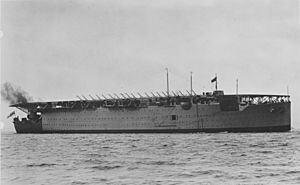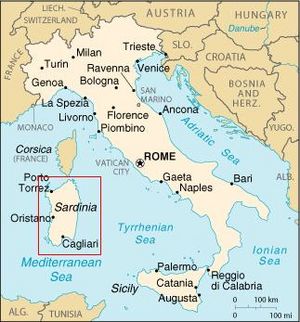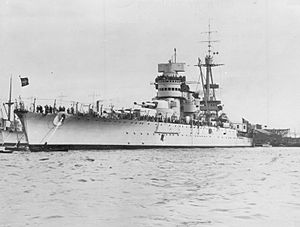Operation White facts for kids
Quick facts for kids Operation White |
|||||||
|---|---|---|---|---|---|---|---|
| Part of the Battle of the Mediterranean of the Second World War | |||||||
 Skua dive bomber forced to crash-land on Sicily |
|||||||
|
|||||||
| Belligerents | |||||||
| Commanders and leaders | |||||||
| James Somerville | Inigo Campioni | ||||||
| Strength | |||||||
|
|
||||||
| Casualties and losses | |||||||
|
None | ||||||
Operation White was a British plan in World War II to send 14 airplanes to Malta on November 17, 1940. These planes included 12 Hawker Hurricane fighter planes and two Blackburn Skua dive bombers. They were carried by the old aircraft carrier HMS Argus.
The mission faced problems because the Italian Navy was nearby. This made the British launch their planes too early. Bad weather also made things worse. In the end, only five planes made it to Malta. Operation White was one of several "Club Runs" that helped supply Malta with fighter planes for its defense.
Contents
Why Malta Was Important
Malta's Role in World War II
When Italy joined World War II on June 10, 1940, the way naval power was shared in the Mediterranean Sea changed. Before, the French Navy handled the western part, and the British handled the eastern part. With France out of the picture, the British Navy (called the Admiralty) created a new group called Force H in Gibraltar.
The British needed a way to send more aircraft to Malta. Malta was a very important island for controlling the Mediterranean. They wanted to make sure Malta had enough planes to defend itself and replace any that were lost. After France was defeated, only two ways were left to get planes to Malta. One way was to fly them across the Sahara desert or through the Suez Canal to Egypt. The other way was to use aircraft carriers to fly them from the western Mediterranean.
Operation Hurry: A Test Run
Before Operation White, there was a similar mission called Operation Hurry. This mission happened on August 2, 1940. Force H was involved, including the carrier HMS Ark Royal, two battleships (HMS Valiant and Resolution), and several cruisers and destroyers.
Nine Fairey Swordfish planes took off from Ark Royal to bomb Cagliari, a city on Sardinia. Three more planes laid mines. The first group of pilots to do a "Club Run" was from the Royal Air Force (RAF). These pilots had been specially trained to take off from a ship.
On August 2, 1940, the aircraft carrier Argus sailed separately from Force H. It had its own escort of destroyers. The planes took off from Argus southwest of Sardinia.
The Italian Navy (called Supermarina) found out about Force H's movements. They sent out submarines to try and stop them, but the submarines didn't find anything. Three Italian Savoia-Marchetti SM.79 medium bombers attacked Force H. However, Skua planes from Ark Royal shot down one of the Italian bombers and chased the other two away.
All the British fighter planes from Operation Hurry successfully reached the airfield at Luqa in Malta. Two of them had to crash-land, but the pilots were safe. The new planes quickly went into action. On August 13, they shot down another Italian bomber. By August 16, these new planes joined with the planes already in Malta to form 261 Squadron.
Planning Operation White
The British Plan: Force H Sets Sail
Because Operation Hurry was a success, the British decided to try another similar mission in November. Again, the aircraft carrier Argus would deliver the planes. Admiral Sir James Somerville led Force H from Gibraltar.
Force H included the battlecruiser HMS Renown, the carrier Ark Royal, two cruisers (HMS Despatch and Sheffield), and several destroyers. The convoy left Gibraltar at dawn on November 15. On the same day, Admiral Somerville received a report. It said that the Italian fleet was south of Naples and might try to stop Force H. Because of this, he decided to launch the fighter planes as soon as possible.
The Italian Response: Regia Marina Moves In
The Italian naval headquarters, Supermarina, learned about the British operation four hours after Force H left Gibraltar. A large Italian fleet, led by Admiral Inigo Campioni, sailed from Naples and Messina.
By the morning of November 17, the Italian fleet was waiting. It included the powerful battleships Vittorio Veneto and Giulio Cesare. They also had two heavy cruisers and many destroyers. They were positioned about 35 miles (56 km) southwest of Sardinia, ready to intercept the British ships.
The Operation Unfolds
The British ships were about 400 miles (640 km) west of Malta when the first group of fighter planes took off from Argus. This happened at 6:15 AM. If the planes flew at the correct speed, they would have had 45 minutes of fuel left when they reached Malta. However, they used up a third of this extra fuel just getting organized and flying together.
The planes flew at 150 miles per hour (240 km/h) at a height of 2,000 feet (610 m). This was not the best speed or height for flying the longest distance.
The second group of planes was launched an hour later. By then, the British convoy was turning back at full speed. The wind also changed direction, making it harder for the planes to fly east towards Malta. Near the Galite Islands, a Short Sunderland flying boat was supposed to meet them. This flying boat would lead the planes the rest of the way to Malta.
Two Hurricanes from the first group ran out of fuel and were lost at 9:08 AM and 9:12 AM. One pilot was saved by the Sunderland flying boat, but the other was lost at sea. The four remaining Hurricanes and the Skua from the first group landed safely at Luqa in Malta at 9:20 AM.
The second group of planes did not get help from the Sunderland. The flying boat failed to take off from Gibraltar to meet them. They also missed the Galite Islands and a bomber sent from Malta to guide them. One by one, the Hurricanes in this group ran out of fuel and crashed into the sea. All the pilots and planes were lost. One Skua plane managed to crash-land near Syracuse, Sicily. This happened just before it ran out of fuel, and after it was shot at by Italian anti-aircraft guns. The two crew members were captured as prisoners of war.
What Happened Next
Admiral Somerville privately called Operation White "a frightful failure." The official investigation blamed the Skua crew at first. However, everyone later agreed that the real reasons for the failure were bad weather, a lack of teamwork between the Navy and the RAF, and the fleet's unwillingness to take more risks.
Losing so many experienced fighter pilots was a big blow. Luckily, some of the most successful pilots, including some who had fought in the Battle of Britain, survived this difficult mission.
See also
Images for kids







